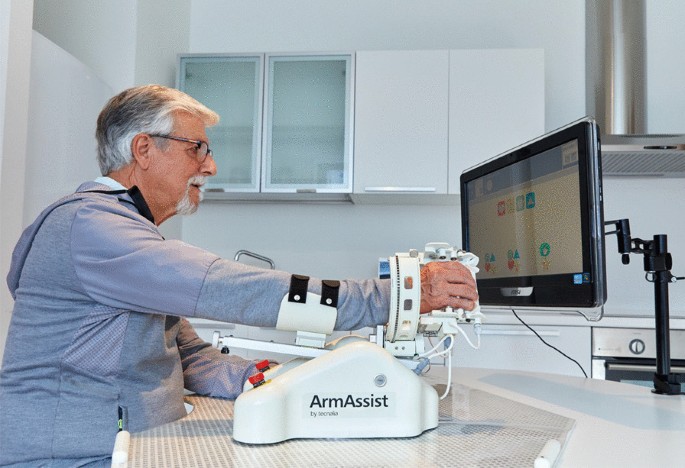So still a failure, no mention of any patient getting to 100% recovery. But it is a success if you ascribe to the tyranny of low expectations like your doctors and therapists do.
HoMEcare aRm rehabiLItatioN (MERLIN): preliminary evidence of long term effects of telerehabilitation using an unactuated training device on upper limb function after stroke
Journal of NeuroEngineering and Rehabilitation volume 18, Article number: 141 (2021)
Abstract
Background
While short term effects on upper limb function of stroke patients after training with robotic devices have been studied extensively, long term effects are often not addressed. HoMEcare aRm rehabiLItatioN (MERLIN) is a combination of an unactuated training device using serious games and a telerehabilitation platform in the patient’s home situation. Short term effects showed that upper limb function improved after training with MERLIN. The aim was to determine long term effects on upper limb function and quality of life.
Methods
Six months after cessation of the 6 week MERLIN training program, the upper limb function and quality of life of 11 chronic stroke patients were assessed. Upper limb function was measured using the Wolf Motor Function Test (WMFT), Action Research Arm Test (ARAT) and Fugl-Meyer Assessment-Upper Extremity (FMA-UE). EuroQoL-5D (EQ-5D) was used to measure quality of life.
Results
The WMFT, ARAT and EQ-5D did not show significant differences 6 months after the training period compared to directly after training. At 6 months follow-up, FMA-UE results were significantly better than at baseline. Time plots showed a decreasing trend in all tests.
Conclusion
Training effects were still present at 6 months follow-up, since arm function seemed similar to directly after training and FMA-UE results were better than at baseline. However, because of the decreasing trend shown in all tests, it is questionable if improvements will be maintained longer than 6 months. Due to the sample size and study design, results should be interpreted with caution.
Trial registration This study is registered at the Netherlands Trial Register (NL7535). Registered 18-02-2019, https://www.trialregister.nl/trial/7535
Introduction
The majority of people who suffered a stroke have persistent problems with using the arm or hand in daily life, with estimates between 62 and 88% [1, 2]. After a severe paresis, only 7–18% regains full function of the upper limb [1, 3]. Actual numbers might be less drastic since these studies are rather dated and specific groups of severely affected stroke patients were investigated. Nevertheless, the latest insights show that improvement of the upper limb function is possible even 1 year after stroke onset [4, 5]. More training possibilities have become available for patients in the chronic phase of stroke. Patients with a better upper limb function may be more independent and less reliant on their caregivers, which is important for a stroke survivor [6]. An improved arm function could also lead to more use of the arm in daily life which in turn is beneficial for further recovery. Additionally, independence of the patient may unburden the health care system due to a lower need for care and adaptations at home or a reduction in the need for long term therapy. More frequent, intensive or longer training programs have been positively correlated with improvement in upper limb function [7]. Many patients would like to receive more training than they are currently offered, unfortunately this is not possible in all instances due to limited healthcare resources [6]. The search for alternative ways to provide therapy is on-going.
A promising solution is to use (robotic) devices to train the upper limb using serious games. Several reviews revealed that robotic training is safe and can provide more intensive training than in standard care situations, especially in the chronic phase [8,9,10]. Robotic training devices seem to improve the upper limb function directly after training [11, 12]. While these are only short term effects, equally important is to know whether training with these devices results in long lasting improvements. In only one review the follow-up after training was described, and the authors concluded that there was no significant difference between a robotic training group and the conventional group when matched for training intensity [8]. This conclusion was based on a meta-analysis using data from only three papers in which two investigated a robotic device and one a non-robotic device [8, 13,14,15]. Evidently, insufficient information is yet available on the long term effects of training with (non)robotic devices.
We investigated the long term effect of hoMEcare aRm rehabiLItatioN (MERLIN), an unactuated (non-robotic) training device combined with a telecare platform to train the arm and hand at home (see Fig. 1). The short term results of MERLIN showed that moderately affected patients in the chronic phase of stroke were able to achieve a statistically significant as well as a clinically relevant improvement in upper limb function [16]. The improvements were retained at least 6 weeks after termination of the training. We expected patients to use the affected arm more in daily life after the intervention due to an improved arm function. Some evidence suggests that after intense therapy, patients are able to use the hand more during different activities with effects lasting up to 1 year [17, 18]. Therefore we hypothesized that upper limb function would improve between cessation of the intervention and 6 months after the intervention. The aim of this study was to assess upper limb function and quality of life in patients in the chronic phase after stroke, who trained with MERLIN at home 6 months prior to the assessment. First we will discuss the difference between our findings directly after the training and the findings at 6 months follow-up. Thereafter, we compare the 6 month follow-up data to the data of all previous measurements.

No comments:
Post a Comment